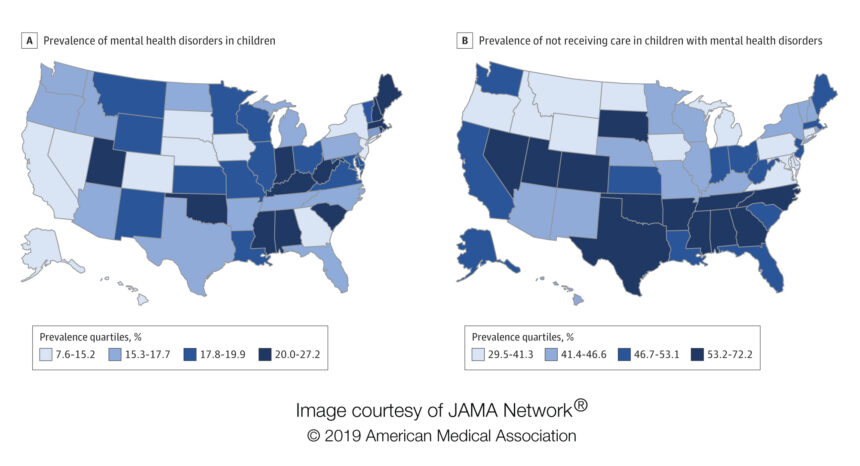An estimated 16.5 percent of children in the United States — about 7.7 million kids — have been diagnosed with depression, anxiety or attention deficit hyperactivity disorder, but about half don’t receive the help they need, according to a new research letter in JAMA Pediatrics.
The study highlights a gap in treatment for kids aged 6 to 17 who have at least one of these three mental health disorders, a finding lead author Daniel Whitney described as “concerning,” in an email to Journalist’s Resource. The study also offers a state-by-state comparison — highlighting areas of the country where youth are most and least likely to have one of these disorders.
To determine the prevalence of mental health disorders and rates of treatment, the authors analyzed data collected in the 2016 National Survey of Children’s Health. The nationally representative survey includes responses from 50,212 parents, who were asked about their kids. The researchers then scaled these responses to calculate estimates for the national population of children in this age group, totaling 46.6 million.
Researchers were interested in children who, at the time of the survey, had been diagnosed by a doctor or other health care provider with at least one of these conditions. As a follow-up, the researchers considered responses to whether the children had received treatment or counseling from a mental health professional in the past year.
Key findings:
- The prevalence of these three disorders varied widely from state to state. Hawaii had the lowest prevalence, at 7.6 percent. Maine had the highest — 27.2 percent.
- Similarly, treatment prevalence varied, too. Washington, D.C. represented the low end of the spectrum. Of the kids there who had been diagnosed with a mental health disorder, 29.5 percent had not received the necessary treatment in the past year. In North Carolina, which had the highest prevalence for untreated mental health disorders in kids, 72.2 percent did not get treatment.
- Four of the 13 states in the top quartile for prevalence of mental health disorders also were in the top quartile for prevalence of kids not receiving treatment. These states were Alabama, Mississippi, Oklahoma and Utah.
Whitney described the association between high prevalence of mental health disorders and high prevalence of untreated conditions as “complex and multifactorial.” He suggested relevant influences might include the children’s parents, their environments, and the children themselves.
“Other reasons may be due to inherent and erroneous limitations to using survey-based data,” Whitney explained. “Accessibility and affordability of healthcare are other factors that are salient to these study findings.” He continued, “Unfortunately, we were not able to tease out these factors for this study, but this certainly requires future investigation.”
Because the survey’s methodology has changed over time, Whitney said it is hard to say how the findings differ from past estimates. He added that estimates might be subject to bias because of stigma about mental health issues. “However,” he told Journalist’s Resource, “national and global initiatives over the past decade or so have done a really nice job in highlighting the problem, and allowing our communities to start to talk about these conditions.”
Story ideas
For journalists looking to localize this issue, the paper offers a map that breaks down prevalence for children’s mental health disorders — both overall and untreated. Further, Whitney suggested that reporters might build on his research by “identifying barriers to seeking and/or receiving treatment for children and adolescents.”


Expert Commentary